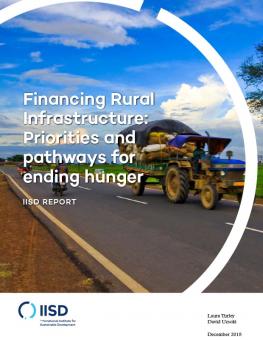
Financing Rural Infrastructure: Priorities and pathways for ending hunger
Read our report to discover how new financial instruments can support a decentralized and robust infrastructure base for farmers, food processors and rural communities.
Key Messages
- Most of the people suffering from hunger around the world live in rural areas and engage in agricultural activity. Financing infrastructure, including roads, storage and localized energy grids, will help provide food security for the 821 million people estimated to live in hunger worldwide.
- About one third of food produced for human consumption is lost or wasted globally, amounting to about 1.3 billion tonnes per year. Storage facilities play a critical role in ensuring food security and ending hunger. Governments should create dedicated funds with a mandate to provide financing for storage infrastructure projects to reduce post-harvest loss.
- Agricultural productivity resulting from irrigation can be more than twice as productive on a per-hectare basis than rainfed production. Investing in water distribution, such as through public–private partnerships, is crucial. Access to reliable water sources positively contributes to women’s empowerment through increased asset ownership and control over resources, better sanitation, local job creation and food security.
Most of the people suffering from hunger around the world live in rural areas and engage in agricultural activity. It is not just a coincidence that they also often lack basic services, such as energy and irrigation provision, due to a lack of infrastructure. This lack of infrastructure is an important reason for their vulnerability to hunger.
This is why our new report explores the importance of financing infrastructure, including roads, storage and localized energy grids: because investment in infrastructure will help provide food security for the 821 million people estimated to live in hunger worldwide.
Investing in rural roads helps connect farmers to markets and links agricultural and non-agricultural communities; building storage bins keeps the harvest fresher longer and sustainable irrigation systems increase yields. Yet financing infrastructure has been notoriously hard historically because investors dislike the risks of agricultural production. Today, new tools are available to us.
Read this report, or our policy brief, to discover how new financial instruments can support a decentralized and robust infrastructure base for farmers, food processors and rural communities.
Participating experts
You might also be interested in
CSDDD: EU's Due diligence law vote should drive supply chain sustainability efforts
The European Parliament has voted to adopt the Corporate Sustainability Due Diligence Directive, aiming to address the environmental and social impacts of the supply chains of Europe's large corporations.
WTO Agriculture Negotiations at MC13: What does the lack of outcomes mean for least developed countries and other vulnerable economies?
IISD expert Facundo Calvo analyzes what came out of the WTO's agriculture negotiations at the 13th Ministerial Conference in Abu Dhabi and its implications for least developed countries and other vulnerable economies.
Monitoring Progress in Green Public Procurement
This report outlines the importance of monitoring progress in green public procurement (GPP) and highlights various methodologies, challenges, and recommendations.
Global Market Report: Soybean prices and sustainability
Less than 3% of soybeans are produced in compliance with sustainability standards. This report unpacks what needs to change to make soybeans a food that protects rather than harms the natural environment.